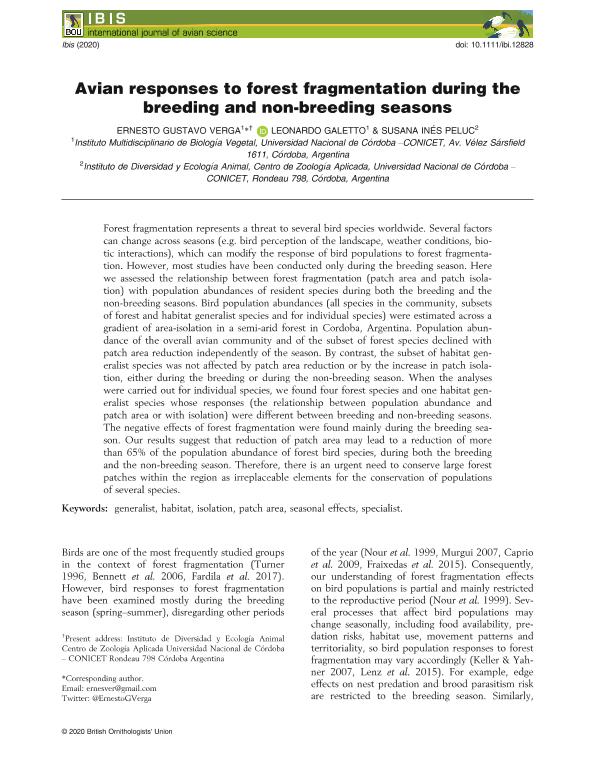Mostrar el registro sencillo del ítem
dc.contributor.author
Verga, Ernesto Gustavo

dc.contributor.author
Galetto, Leonardo

dc.contributor.author
Peluc, Susana Ines

dc.date.available
2021-09-27T17:56:09Z
dc.date.issued
2020-10
dc.identifier.citation
Verga, Ernesto Gustavo; Galetto, Leonardo; Peluc, Susana Ines; Avian responses to forest fragmentation during the breeding and non-breeding seasons; Wiley Blackwell Publishing, Inc; Ibis; 162; 4; 10-2020; 1237-1250
dc.identifier.issn
0019-1019
dc.identifier.uri
http://hdl.handle.net/11336/141614
dc.description.abstract
Forest fragmentation represents a threat to several bird species worldwide. Several factors can change across seasons (e.g. bird perception of the landscape, weather conditions, biotic interactions), which can modify the response of bird populations to forest fragmentation. However, most studies have been conducted only during the breeding season. Here we assessed the relationship between forest fragmentation (patch area and patch isolation) with population abundances of resident species during both the breeding and the non-breeding seasons. Bird population abundances (all species in the community, subsets of forest and habitat generalist species and for individual species) were estimated across a gradient of area-isolation in a semi-arid forest in Cordoba, Argentina. Population abundance of the overall avian community and of the subset of forest species declined with patch area reduction independently of the season. By contrast, the subset of habitat generalist species was not affected by patch area reduction or by the increase in patch isolation, either during the breeding or during the non-breeding season. When the analyses were carried out for individual species, we found four forest species and one habitat generalist species whose responses (the relationship between population abundance and patch area or with isolation) were different between breeding and non-breeding seasons. The negative effects of forest fragmentation were found mainly during the breeding season. Our results suggest that reduction of patch area may lead to a reduction of more than 65% of the population abundance of forest bird species, during both the breeding and the non-breeding season. Therefore, there is an urgent need to conserve large forest patches within the region as irreplaceable elements for the conservation of populations of several species.
dc.format
application/pdf
dc.language.iso
eng
dc.publisher
Wiley Blackwell Publishing, Inc

dc.rights
info:eu-repo/semantics/openAccess
dc.rights.uri
https://creativecommons.org/licenses/by-nc-sa/2.5/ar/
dc.subject
GENERALIST
dc.subject
HABITAT
dc.subject
ISOLATION
dc.subject
PATCH AREA
dc.subject
SEASONAL EFFECTS
dc.subject
SPECIALIST
dc.subject.classification
Ecología

dc.subject.classification
Ciencias Biológicas

dc.subject.classification
CIENCIAS NATURALES Y EXACTAS

dc.title
Avian responses to forest fragmentation during the breeding and non-breeding seasons
dc.type
info:eu-repo/semantics/article
dc.type
info:ar-repo/semantics/artículo
dc.type
info:eu-repo/semantics/publishedVersion
dc.date.updated
2021-09-06T15:47:04Z
dc.identifier.eissn
1474-919X
dc.journal.volume
162
dc.journal.number
4
dc.journal.pagination
1237-1250
dc.journal.pais
Reino Unido

dc.journal.ciudad
Londres
dc.description.fil
Fil: Verga, Ernesto Gustavo. Consejo Nacional de Investigaciones Científicas y Técnicas. Centro Científico Tecnológico Conicet - Córdoba. Instituto de Diversidad y Ecología Animal. Universidad Nacional de Córdoba. Facultad de Ciencias Exactas Físicas y Naturales. Instituto de Diversidad y Ecología Animal; Argentina
dc.description.fil
Fil: Galetto, Leonardo. Consejo Nacional de Investigaciones Científicas y Técnicas. Centro Científico Tecnológico Conicet - Córdoba. Instituto Multidisciplinario de Biología Vegetal. Universidad Nacional de Córdoba. Facultad de Ciencias Exactas Físicas y Naturales. Instituto Multidisciplinario de Biología Vegetal; Argentina
dc.description.fil
Fil: Peluc, Susana Ines. Consejo Nacional de Investigaciones Científicas y Técnicas. Centro Científico Tecnológico Conicet - Córdoba. Instituto de Diversidad y Ecología Animal. Universidad Nacional de Córdoba. Facultad de Ciencias Exactas Físicas y Naturales. Instituto de Diversidad y Ecología Animal; Argentina
dc.journal.title
Ibis

dc.relation.alternativeid
info:eu-repo/semantics/altIdentifier/url/https://onlinelibrary.wiley.com/doi/abs/10.1111/ibi.12828
dc.relation.alternativeid
info:eu-repo/semantics/altIdentifier/doi/http://dx.doi.org/10.1111/ibi.12828
Archivos asociados
